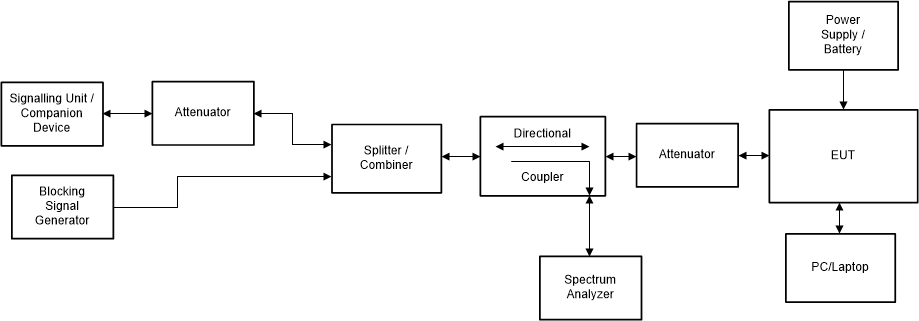SWRA681 September 2020 CC3100 , CC3100MOD , CC3120 , CC3120MOD , CC3135 , CC3135MOD , CC3200 , CC3200MOD , CC3220MOD , CC3220MODA , CC3220R , CC3220S , CC3220SF , CC3235MODAS , CC3235MODASF , CC3235MODS , CC3235MODSF , CC3235S , CC3235SF
- Abstract
- Trademarks
- 1Introduction
- 2CE Conformity Test Requirements and Test Procedure for Wi-Fi Devices
-
3Test Procedure for Compliance Testing - EN
300 328
- 3.1 Product Information as per Annex-E of EN 300 328
- 3.2 RF Output Power - EN 300 328
- 3.3 Power Spectral Density - EN 300 328
- 3.4 Occupied Channel Bandwidth (OCBW) - EN 300 328
- 3.5 Transmitter Unwanted Emissions in the OOB Domain - EN 300 328
- 3.6 Transmitter Unwanted Emissions in the Spurious Domain - EN 300 328
- 3.7 Adaptivity (Channel Access Mechanism) - EN 300 328
- 3.8 Receiver Spurious Emissions - EN 300 328
- 3.9 Receiver Blocking - EN 300 328
-
4Test Procedure for Compliance Testing for
Wi-Fi Devices - EN 301 893
- 4.1 Product Information as per Annex-G of EN 301 893
- 4.2 Test Channels - EN 301 893
- 4.3 Nominal Center Frequencies - EN 301 893
- 4.4 Occupied Channel Bandwidth (OCBW) - EN 301 893
- 4.5 RF Output Power - EN 301 893
- 4.6 Power Spectral Density - EN 301 893
- 4.7 Tx Unwanted Emissions Outside the 5 GHz RLAN Band - EN 301 893
- 4.8 Tx Unwanted Emissions Within the 5 GHz RLAN Bands - EN 301 893
- 4.9 Receiver Spurious Emissions - EN 301 893
- 4.10 Receiver Blocking - EN 301 893
- 4.11 Adaptivity (Channel Access Mechanism) - EN 301 893
- 4.12 Dynamic Frequency Selection (DFS) - EN 301 893
- 4.13 User Access Restrictions - EN 301 893
- 5Test Procedure for Compliance Testing for Wi-Fi Devices - EN 301 489
- 6Test Procedure for Compliance Testing for Wi-Fi Devices – IEC 62368-1
- 7Test Assessment for Human Exposure Restrictions – EN 62311
- 8References
3.9 Receiver Blocking - EN 300 328
The measurements for Receiver Blocking are performed at normal environmental conditions only. For non-FHSS equipment, having more than one operating channel, the operating channels on which the testing has to be performed are selected as follows:
- For testing blocking frequencies less than 2400 MHz, the equipment operates on the lowest operating channel.
- For testing blocking frequencies greater than 2500 MHz, the equipment operates on the highest operating channel.
Figure 3-2 shows the test setup for Receiver Blocking. The test results comply with the Receiver Category-1 limits shown in the Limits on Receiver Blocking (All Categories) - Non-FHSS Equipment table in CE Regulations for SRDs Operating in License-Free 2.4 GHz/5 GHz Bands [1] and are recorded in the test report. The test procedure for Receiver Blocking measurements is described in the following steps:
 Figure 3-2 Test Setup for Receiver Blocking –
EN 300 328
Figure 3-2 Test Setup for Receiver Blocking –
EN 300 328- Make the test setup as shown in Test Setup for Receiver Blocking – EN 300 328.
- Switch ON the EUT and other test equipment.
- For test procedures, see clause 5.4.11.2.1 of EN 300 328 [3].
- Turn-Off the RF on the Blocking Signal Generator.
- Use the Radio Testing Tool [9] to setup and configure the EUT. For setting and up configuring the EUT, see the Radio Testing Tool User's Guide [10].
- Open the Radio Testing Tool [9] and setup the link with the EUT by using the Setup tab.
- Open the Rx tab and select the desired parameters such as Channel / Frequency, Data Rate, Data Pattern, and so forth.).
- Click on “Start Rx Testing”.
- Open the Radio Testing Tool 9] and setup the link with the Companion device by using Setup tab or use AP configuration tool to configure AP to the desired parameters (if AP is used as companion device).
- Open the Tx tab, select the transmission mode to “packetized”.
- Configure the Companion Device to the same parameters such as Channel/Frequency, Data Rate, Data Pattern, Power, and so forth) used for EUT.
- Click on “Start Tx Testing”.
- Adjust the Attenuator setting and or Tx power of the Companion device to obtain a desired signal level (-68 dBm) at the EUT port.
- Observe the Rx statistics on the Rx tab of the EUT. Make sure that the PER/FER is at 0% (no errors before adding the interferer).
- Turn ON the RF signal on the Blocking Signal Generator, set the mode to CW, set the Frequecy as per the Limits on Receiver Blocking (All Categories) - Non-FHSS Equipment table in CE Regulations for SRDs Operating in License-Free 2.4 GHz/5 GHz Bands [1] and adjust the level to >=-34 dBm at the EUT port.
- Observe the Rx statistics on the Rx of the EUT. Measure the PER/FER and record it.
- If the PER/FER is <= 10%, then it passed the test at that blocking frequency.
- Repeat the above steps for other Blocking frequencies as per the Limits on Receiver Blocking (All Categories) - Non-FHSS Equipment table in CE Regulations for SRDs Operating in License-Free 2.4 GHz/5 GHz Bands [1] .
- The Receiver Blocking test results comply with the Receiver Category-1 limits shown in the Limits on Receiver Blocking (All Categories) - Non-FHSS Equipment table in CE Regulations for SRDs Operating in License-Free 2.4 GHz/5 GHz Bands [1] for all the test cases.